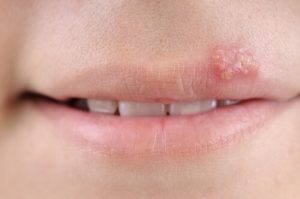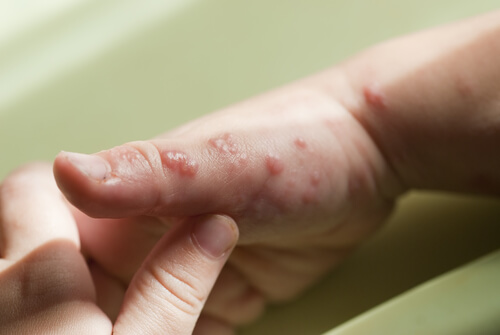Herpes in Children: Symptoms, Causes and Treatment

Herpes in children is a much more common infection than you might think, given the high degree of contagion. And once it’s acquired, the body carries it for life.
Herpes is a viral infectious disease that causes the appearance of skin lesions. It manifests as a set of small vesicles surrounded by a red circle.
It’s caused by the herpes simplex virus, or herpes hominis virus, type 1 (HSV – 1) which can affect the face, lips and upper body; or type 2 (HSV – 2) which commonly occurs in the genitals.
The first type is more frequent in children, although there are also cases of the second type.
In herpes type 1, the most commonly affected area (and perhaps the most annoying) is the lips.
There is another variety, called herpes zoster (also called shingles), which occurs as a result of a persistent varicella virus.
It affects nerve cells on the skin and manifests as blisters on a specific area of the body, accompanied by burning or throbbing pain and tingling or itching.
Herpes has no definitive cure, although there are several treatments to accelerate the healing process of the lesions.
Once this happens, the virus remains dormant in the body until the next activation. Their place of “lodging” are the sensitive nervous ganglia.
Symptoms and appearance of herpes in children
The period of infectious onset can last between 10–14 days. At first, there is a reddening of the affected area and usually some itching as well.
Then, the fluid-filled vesicles appear, which causes some pain. Once they burst, they leave a kind of scab that takes a few days to disappear.
The good news? They don’t leave marks, and the vast majority of the time, they don’t cause major complications.
In any case, there are studies that link it to the appearance of Alzheimer’s in adults.
If it occurs for the first time in a child, it’s very likely that herpes will cause fever and swollen lymph nodes.
According to the American Association of Pediatricians, in newborns the herpes virus can cause more serious complications, such as diseases of the brain, lungs and liver, as well as ulcers on the skin and eyes.
In the most extreme cases, it can pose risks to the baby’s life.
Herpes zoster, meanwhile, is presented in the same way at the beginning. The difference is that the blisters are usually more painful.
This type of herpes can also be accompanied by abdominal pain, fever, chills, joint pain and headaches.
In newborns, the herpes virus can cause serious complications.
In both types, if the fluid that emanates from the blisters comes into contact with an uninfected area of the body, it can then also appear in that place.
It is important to take necessary precautions so this doesn’t happen.
Causes of herpes in children
The main cause is contagion on the part of adults, since between 70% and 90% of them carry the virus.
However, there are other possible sources for the appearance of herpes in children:
- During delivery: it can happen if the mother has an active infection
- Direct contagion: by kisses or contact with the affected areas. Herpes is an extremely contagious infection.
- Indirect infection: through towels, glasses, toys or any other element that has been in contact with someone infected.
- Sexual transmission: this is the form of infection for genital herpes.
- Reappearance of the latent virus: sometimes this happens in response to a cold, heat, fever, stress or exposure to sunlight.
How is it cured?
In the case of infections in newborns, they’re hospitalized and treated in intensive care, due to the possible consequences of the virus.

The other effects can usually be treated at home. In addition, the use of antiviral drugs can accelerate the healing process and prevent the virus from spreading further. There are also natural remedies to treat it.
It is important to keep some points in mind when caring for a child with herpes:
- Provide plenty of liquid to prevent dehydration.
- Don’t give food that can irritate ulcers.
- Check that there is no fever, swollen glands or other discomfort. If this happens, call your pediatrician.
As we said earlier, herpes doesn’t go away completely. It’s only possible to accelerate the treatment, but it will stay inactive in the body of the person carrying the virus.
Can herpes in children be prevented?
There are no great secrets surrounding the prevention of herpes in children. It’s best to avoid contact with anyone who has an outbreak.
In the same way, it’s advisable not to take the child to school if he has symptoms.
In young people and sexually active adults, the use of latex condoms or sexual abstinence are the best methods to prevent any sexually transmitted diseases, including herpes.
All cited sources were thoroughly reviewed by our team to ensure their quality, reliability, currency, and validity. The bibliography of this article was considered reliable and of academic or scientific accuracy.
- Pousa Castro X, Bascones Martínez A. Herpesvirus. Av. Odontoestomatol 2011; 27 (1): 11-24.
- Baquero Artigao F, Prieto Tato LM, Ramos Amador JT, et al. Guía de la Sociedad Española de Infectología Pediátrica sobre prevención, diagnóstico y tratamiento de la infección neonatal por virus herpes simplex. An Pediatría. 2018;89(1):64.e1-64.e10. doi:10.1016/j.anpedi.2018.01.004.
This text is provided for informational purposes only and does not replace consultation with a professional. If in doubt, consult your specialist.








